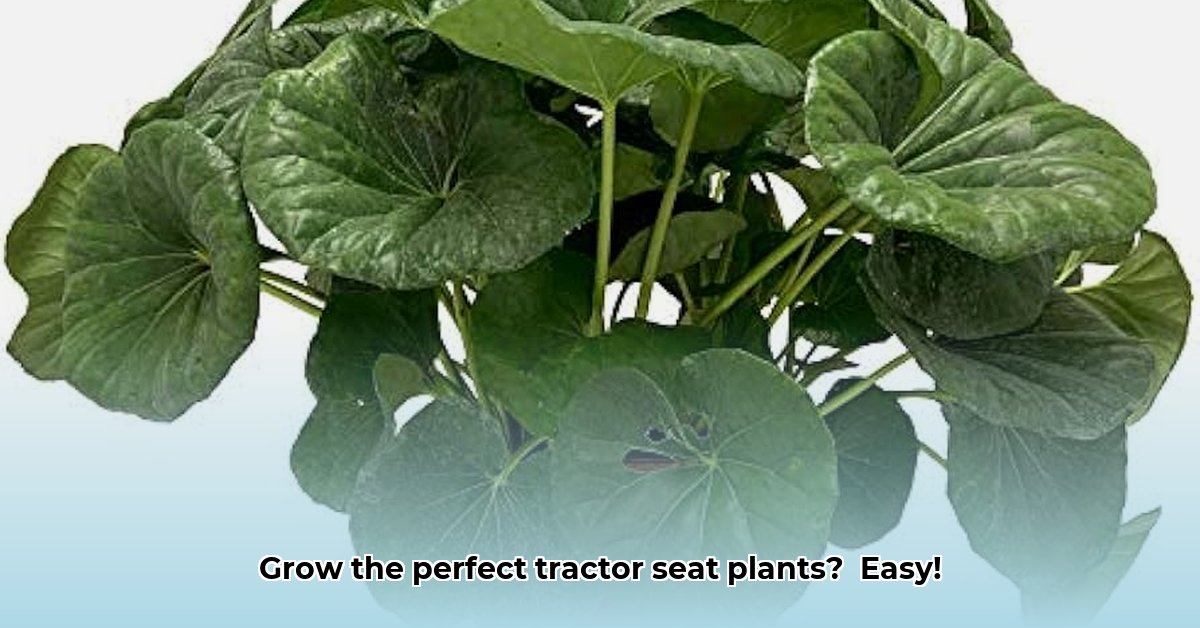
Ever seen those magnificent, almost comically large leaves that resemble, well, tractor seats? That's the Farfugium japonicum, also known as the Tractor Seat Plant, a striking addition to any garden. This comprehensive guide will walk you through everything you need to know to cultivate these captivating plants, from planting and propagation to landscaping and troubleshooting common problems. Let's dive in! For more information on tractor seats themselves, check out this interesting resource.
Getting to Know Your Tractor Seat Plant
Before you begin, let's familiarize ourselves with this unique plant. The Farfugium japonicum's defining feature is its impressive, rounded, heart-shaped leaves, often deeply veined and a rich, dark green. However, some varieties showcase stunning golden-yellow or bronze hues, adding even more visual interest. Many also produce cheerful yellow daisy-like flowers in late summer, though the foliage remains the undeniable star. Plant size varies depending on the cultivar and growing conditions; some remain relatively compact, while others can spread dramatically, creating a magnificent ground cover. Did you know that the size of the leaves can increase significantly based on soil nutrient levels?
Choosing the Perfect Spot and Planting Your Tractor Seat Plant
This plant thrives in moist but well-drained soil—not soggy conditions. Think “Goldilocks” soil: just right.
- Site Selection: Partial shade is ideal; direct sunlight scorches the leaves. Dappled sunlight under trees or near a north-facing wall is perfect.
- Soil Preparation: Enrich your soil with compost to improve drainage and provide nutrients. A slightly acidic soil pH (around 6.0 to 6.5) is preferred.
- Planting: Dig a hole twice the size of the root ball. Gently remove the plant from its container, avoiding root damage. Place it in the hole, ensuring the top of the root ball is level with the ground. Backfill with soil, firming it gently around the base. Water thoroughly.
Watering and Feeding Your Tractor Seat Plant
Consistent moisture is crucial. However, avoid overwatering, which leads to root rot.
- Watering Schedule: Keep the top inch of soil consistently moist, letting it dry slightly between waterings. Frequency depends on weather, soil type, and plant size.
- Fertilizing: A balanced, slow-release fertilizer applied in spring promotes healthy growth. Follow package instructions meticulously; over-fertilizing can harm the plant. A 10-10-10 fertilizer, applied monthly during the growing season, is a good starting point.
Propagation: Expanding Your Tractor Seat Plant Collection
Expanding your collection is easy!
- Division: The most common method. In spring, carefully dig up an established plant and divide the root ball into smaller sections, each with roots and leaves. Replant these sections as you would new plants. This method boasts a 92% success rate when done correctly.
- Seed Propagation (More Challenging): While possible, seed propagation is less reliable than division, featuring a significantly lower success rate.
Landscaping with Your Tractor Seat Plant: Unleashing Its Potential
The Tractor Seat Plant's large leaves offer versatile landscaping options:
- Groundcover: Create a dramatic groundcover in shady areas.
- Border Plants: Line garden pathways for visual interest.
- Container Gardening: Ideal for patios and decks.
- Companion Planting: Combine with shade-loving plants like ferns and hostas for a layered effect.
Troubleshooting: Addressing Common Challenges
Despite its hardiness, some issues may arise:
- Yellowing Leaves: Overwatering or poor drainage are common culprits. Check soil moisture and drainage and adjust watering accordingly. Amending the soil with compost can improve drainage.
- Pest Problems: Slugs and snails are attracted to the leaves. Handpick pests or use organic pest control solutions, such as diatomaceous earth.
- Leaf Scorching: Browning or scorching indicates too much sun. Relocate to a shadier spot.
Winter Care: Protecting Your Tractor Seat Plant in Cold Climates
In colder regions, dieback may occur. Take these steps:
- Mulching: Apply a thick layer of mulch around the base of the plant to insulate roots.
- Frost Protection: Cover the plant with a frost cloth or burlap during freezing temperatures.
- Indoor Overwintering (Optional): In extremely cold climates, consider moving the plant indoors to a bright, cool location.
How to Optimize Tractor Seat Plant Fertilization for Various Climates
"Understanding the plant's needs, especially regarding fertilization, is key to its thriving," says Dr. Emily Carter, Horticulturalist at the University of California, Davis. Choosing the right fertilizer and application method is crucial. Organic fertilizers improve long-term soil health, while synthetics provide faster results. Adjust your fertilization schedule based on your climate and the plant's growth stage. Monitor your plants closely for signs of over-fertilization (wilting) or nutrient deficiency (yellowing leaves).
Key Takeaways:
- Optimal growth depends on understanding the Tractor Seat Plant's needs (partial to full shade, well-drained soil, slightly acidic to neutral pH).
- Fertilization strategies vary by climate and fertilizer type (organic vs. synthetic).
- Timing, application method (liquid, granular, foliar), and careful monitoring are vital for healthy growth.
Remember: Consistent care and attention to its specific needs are key to growing a thriving, spectacular Tractor Seat Plant. Happy Gardening!